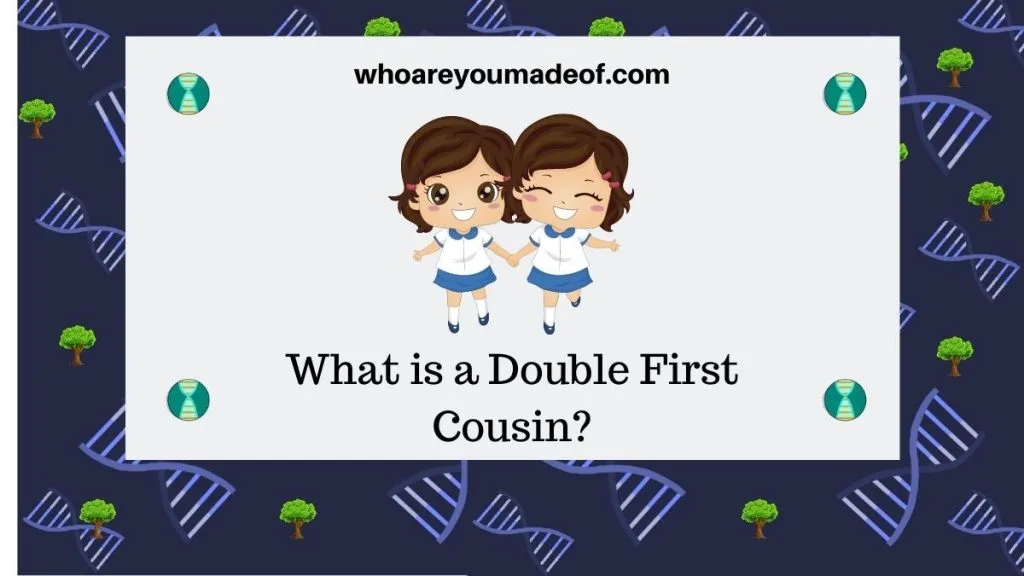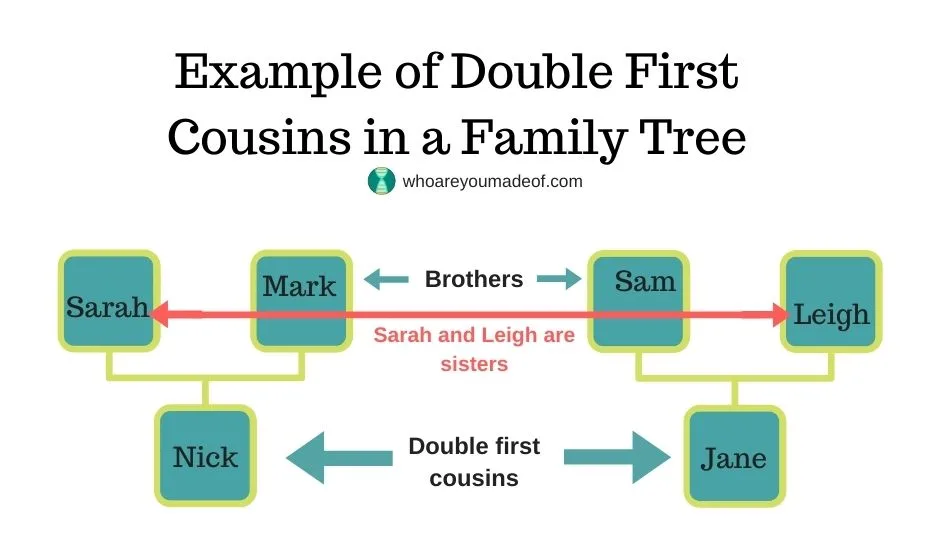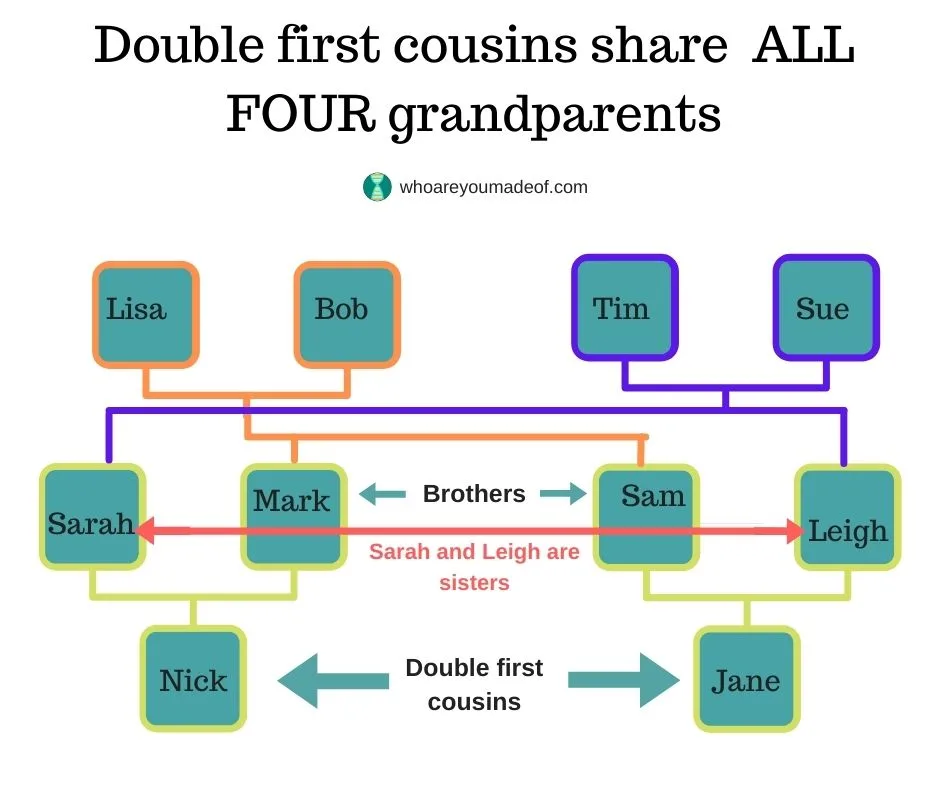A double first cousin is a person who is your first cousin - twice. In this article, find out exactly how double first cousins are related, as well as see a family tree example.
Most of us - if we look hard enough - can find double cousins in our family tree. In fact, we might even be double cousins to some of our relatives.

There are many types of double cousins, but the most commonly inquired about is the double first cousin. Double first cousins were more common throughout history than they are today, but even nowadays we can find examples of this degree of consanguinity.
Whether your double first cousin curiosity stems from finding this among distant ancestors in your family tree, or if you think you might be a double first cousin yourself, you will find the answers that you need below.
Exactly what is a double first cousin
Double first cousins are first cousins, twice, because they share both sets of grandparents. This occurs because both of the parents of one double first cousin are the siblings of the parents of the other double first cousin.
It's easy enough to imagine how two sets of siblings would meet, marry, and produce children. For example, perhaps a sister meets a great guy, who happens to have a great brother that she would like to introduce to her sister.
If all goes well, the sisters each marry a different brother from the same family. The offspring of those two couples will be double-first cousins.
Most of the examples that I have seen in my own family tree have occurred between two sisters marrying two brothers. However, is a brother and a sister marry a brother and a sister from another family, their children would also be double first cousins to each other.
In other words, the gender of the marrying siblings doesn't matter - their children will always be double first cousins.
How are double first cousins related?
Double first cousins are twice as related to each other as the "regular" first cousin. In addition, because they share all four grandparents in common, they also share 100% of their ancestors with each other - which is twice as much as the 50% that typical first cousins share.
This is because double first cousins share as most recent common ancestors (MRCA) four grandparents, instead of the typical two.
A double first cousin relationship can make family reunions pretty fun! Imagine a first cousin who attends reunions on both sides of the family because they, too, are just as related to everyone as you are.
Furthermore, double first cousins share all of their relatives with each other - not just ancestors. Anyone who is biologically related to one cousin will also be related to the other double-first cousin.
This certainly makes family tree research easier, since all cousins will be equally as interested (hopefully!) in learning about their heritage.
Double first cousins family tree example
Sometimes it is easier to picture cousin relationships by looking at a family tree example. In the graphic below, we see that two sisters (Sarah and Leigh) married brothers (Mark and Sam), and their children (Nick and Jane) are double first cousins.

You can see the red arrow pointing to Sarah and Leigh, and this indicates that they are sisters. Mark and Sam are brothers, which is indicated by the small green arrow.
Nick is the son of Sarah and Mark, and Jane is the daughter of Sam and Leigh. Nick and Jane are double first cousins.
We can't really see what is going on as far as shared ancestors in that graphic, however. To visualize how it is that Nick and Jane share all four grandparents, as well as 100% of their more distant ancestors, we will need to look at a different graphic.

In the above image, we can clearly see that Lisa and Bob are the parents of Mark and Sam. You can follow the orange lines from their place in the family tree to their sons.
In addition, we can see that Tim and Sue are the parents of Leigh and Sarah, and we can follow their purple lines to their daughters.
If you start at Nick in the family tree, you will always end up at either Lisa and Bob, or Tim and Sue, as you work back in the tree. In addition, the double first cousins (Nick and Jane) will share all of the ancestors of their grandparents (Lisa, Bob, Tim and Sue) in common.
In the case of "typical" first cousins, we find that cousins share 50% of their ancestors with each other. This is because they will typically share only two grandparents, as is the case with full first cousins.
Are double cousins genetically siblings?
Double first cousins will share twice as much DNA with each other than typical first cousins will share. "Average" first cousins share 12.5% of their DNA (about ⅛ of the total), which double-first cousins will share about 25% (or ¼).
As it happens, half-siblings generally share about 25% of their DNA. In other words, double first cousins share about as much DNA as half-siblings.
This doesn't necessarily mean that double first cousins are siblings. Instead, it means that they have much more in common, from a genetic standpoint, than most first cousins do.
In addition, we would expect double first cousins to show up as a very close family match on a DNA test. Their descendants, who will be double second, third, and fourth cousin, may also be closer genetic matches than typical cousins of that relationship distance.
Conclusion
I hope that this post has helped you understand more about double first cousins, including exactly how they are related and how being double first cousins affects their genetic relationship.
If you have any questions about double first cousins, or if you would like to share an example of them that you have found in your family tree, I would love for you to post a comment in the discussion below.
Thanks for stopping by today!

Anonymus
Wednesday 3rd of January 2024
I have a double first cousin and she comes to my house every weekend. Basically her mother is my father's sister and her father is my mother's brother
Rose Lovato
Sunday 24th of September 2023
Hello- my double first cousins are listed as my nieces and I’m listed as their aunt-one shows up as 30.61 dna w/57 segments and the other w/24.73% dna w/48 segments- their children show up as great niece; etc, I’m confused,
Victor Flores
Thursday 8th of June 2023
My half brother fathered a daughter with the sister of my first wife. With whom I fathered 3 children. Making our kids cousins on both sides. But since my brother and I are half siblings, would my children still be double cousins to his daughter?
Mike L.
Saturday 22nd of April 2023
So... my double 4th cousin (which we have ancestors whom were double 1st cousins), is genetically similar as a 3rd cousin?
There's a headache to think about. IDC, I'm still not "kissing" them. Seems about as wrong as marrying an adopted sibling. They may not be technically related but I sure wouldn't marry one of my sibling's sister-in-law.
Moira Mark
Friday 7th of October 2022
My Mom and Dad, as I know it without DNA, are first cousins. My Paternal Grandfather married one sister and my Maternal grandfather married another sister (full siblings). So, of course, from reading the above, I am considered a "double cousin." Sharing 25% DNA thru Grandfather, etc. Your example states two brothers marrying two sisters their offspring share all four grandparents. I share just three. Am I correct in assuming that the gender does not matter, since my mom and dad are first cousins, or is there a different formula.
Thank you. Moira